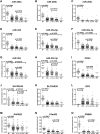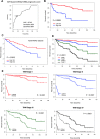Epithelial-mesenchymal transition-associated microRNA/mRNA signature is linked to metastasis and prognosis in clear-cell renal cell carcinoma
- PMID: 27549611
- PMCID: PMC4994011
- DOI: 10.1038/srep31852
Epithelial-mesenchymal transition-associated microRNA/mRNA signature is linked to metastasis and prognosis in clear-cell renal cell carcinoma
Abstract
Clear-cell renal cell carcinomas (ccRCCs) are genetically heterogeneous tumors presenting diverse clinical courses. Epithelial-mesenchymal transition (EMT) is a crucial process involved in initiation of metastatic cascade. The aim of our study was to identify an integrated miRNA/mRNA signature associated with metastasis and prognosis in ccRCC through targeted approach based on analysis of miRNAs/mRNAs associated with EMT. A cohort of 230 ccRCC was included in our study and further divided into discovery, training and validation cohorts. EMT markers were evaluated in ccRCC tumor samples, which were grouped accordingly to EMT status. By use of large-scale miRNA/mRNA expression profiling, we identified miRNA/mRNA with significantly different expression in EMT-positive tumors and selected 41 miRNAs/mRNAs for training phase of the study to evaluate their diagnostic and prognostic potential. Fifteen miRNAs/mRNAs were analyzed in the validation phase, where all evaluated miRNA/mRNA candidates were confirmed to be significantly deregulated in tumor tissue. Some of them significantly differed in metastatic tumors, correlated with clinical stage, with Fuhrman grade and with overall survival. Further, we established an EMT-based stage-independent prognostic scoring system enabling identification of ccRCC patients at high-risk of cancer-related death. Finally, we confirmed involvement of miR-429 in EMT regulation in RCC cells in vitro.
Figures





Comment in
-
Basic/Translational Science Survey: Kidney Cancer.Urol Oncol. 2017 Apr;35(4):160. doi: 10.1016/j.urolonc.2017.01.011. Urol Oncol. 2017. PMID: 28340690 No abstract available.
Similar articles
-
MicroRNAs with prognostic potential for metastasis in clear cell renal cell carcinoma: a comparison of primary tumors and distant metastases.Ann Surg Oncol. 2014 Mar;21(3):1046-54. doi: 10.1245/s10434-013-3361-3. Epub 2013 Nov 18. Ann Surg Oncol. 2014. PMID: 24242678
-
Downregulation of FOXO3a promotes tumor metastasis and is associated with metastasis-free survival of patients with clear cell renal cell carcinoma.Clin Cancer Res. 2014 Apr 1;20(7):1779-90. doi: 10.1158/1078-0432.CCR-13-1687. Epub 2014 Jan 31. Clin Cancer Res. 2014. PMID: 24486593
-
Hypoxia-induced overexpression of stanniocalcin-1 is associated with the metastasis of early stage clear cell renal cell carcinoma.J Transl Med. 2015 Feb 12;13:56. doi: 10.1186/s12967-015-0421-4. J Transl Med. 2015. PMID: 25740019 Free PMC article.
-
Epithelial-mesenchymal transition-associated miRNAs in ovarian carcinoma, with highlight on the miR-200 family: prognostic value and prospective role in ovarian cancer therapeutics.Cancer Lett. 2014 Sep 1;351(2):173-81. doi: 10.1016/j.canlet.2014.05.022. Epub 2014 Jun 18. Cancer Lett. 2014. PMID: 24952258 Review.
-
The complex roles of microRNAs in the metastasis of renal cell carcinoma.J Nanosci Nanotechnol. 2013 May;13(5):3195-203. doi: 10.1166/jnn.2013.6712. J Nanosci Nanotechnol. 2013. PMID: 23858831 Review.
Cited by
-
MicroRNA-132 suppresses migration and invasion of renal carcinoma cells.J Clin Lab Anal. 2020 Jan;34(1):e22969. doi: 10.1002/jcla.22969. Epub 2019 Oct 17. J Clin Lab Anal. 2020. PMID: 31625200 Free PMC article.
-
Isolated Pancreatic Metastases of Renal Cell Cancer: Genetics and Epigenetics of an Unusual Tumour Entity.Cancers (Basel). 2022 Mar 17;14(6):1539. doi: 10.3390/cancers14061539. Cancers (Basel). 2022. PMID: 35326690 Free PMC article. Review.
-
MicroRNA-34a targets epithelial to mesenchymal transition-inducing transcription factors (EMT-TFs) and inhibits breast cancer cell migration and invasion.Oncotarget. 2017 Mar 28;8(13):21362-21379. doi: 10.18632/oncotarget.15214. Oncotarget. 2017. PMID: 28423483 Free PMC article.
-
Overexpression of ANXA3 is an independent prognostic indicator in gastric cancer and its depletion suppresses cell proliferation and tumor growth.Oncotarget. 2016 Dec 27;7(52):86972-86984. doi: 10.18632/oncotarget.13493. Oncotarget. 2016. PMID: 27894078 Free PMC article.
-
Rationale for immune checkpoint inhibitors plus targeted therapy for advanced renal cell carcinoma.Heliyon. 2024 Apr 4;10(7):e29215. doi: 10.1016/j.heliyon.2024.e29215. eCollection 2024 Apr 15. Heliyon. 2024. PMID: 38623200 Free PMC article. Review.
References
-
- Ljungberg B. et al.. EAU guidelines on renal cell carcinoma: 2014 update. European Urology. 67, 913–24 (2015). - PubMed
-
- Williamson T. J., Pearson J. R., Ischia J., Bolton D. M. & Lawrentschuk N. Guideline of Guidelines: follow-up after nephrectomy for renal cell carcinoma. BJU international. 117, 555–62 (2015). - PubMed
-
- Li H., Samawi H. & Heng D. Y. The use of prognostic factors in metastatic renal cell carcinoma. Urologic Oncology. 33, 509–16 (2015). - PubMed
-
- Dusek L. et al.. Cancer incidence and mortality in the Czech Republic. Klinicka onkologie. 27, 406–23 (2014). - PubMed
-
- Lohse C. M., Gupta S. & Cheville J. C. Outcome prediction for patients with renal cell carcinoma. Seminars in Diagnostic Pathology. 32, 172–83 (2015). - PubMed
Publication types
MeSH terms
Substances
LinkOut - more resources
Full Text Sources
Other Literature Sources
Medical

